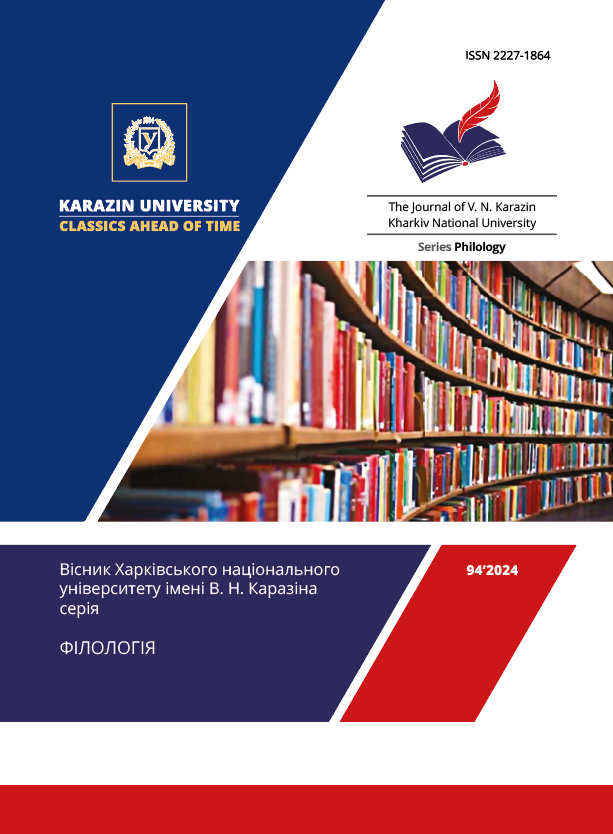The theory of the sentence secondary members in D. M. Ovsianyko-Kulykovskyі’s syntax studies and its practical implementation
Abstract
A valuable contribution to the development of views on sentence syntax problems was made by the outstanding scientist of Kharkiv Linguistic School D. M. Ovsianyko-Kulykovskyі, in particular the views on such problems as the structure of the simple sentence, the ways of expressing each member of the sentence and its syntactical relations. The aim of this article is to analyze the classification of secondary members of the sentence, objects in particular, suggested by D. M. Ovsianyko-Kulykovskyі, the influence of his studies on modern syntax theories and suggest criteria of discovering the presence of object relations between the verb and its direct object.
Dividing all members of the sentence into main and secondary ones D. M. Ovsianyko-Kulykovskyі analizes the major way of expression of each of them. Semantic functions of indirect cases are given in the description of objects. Studying government in phrases he singles out relations conditioned by the lexical meaning of the verb, grammatical meaning of the verb and also weakly connected forms, the so-called “fictitious” objects or objects-adverbial modifiers. The analysis of the sentence lexical and semantic filling aimed at the definition of the sentence secondary members makes D. M. Ovsianyko-Kulykovskyі’s studies topical at present. The verb and its object relations are very important for the sentence sense understanding, the special role played by the direct object construction. Studying the problem of interrelation and interaction of object phrase semantics and structure was directed at stage-by-stage analysis of the phrase grammatical structure, its components semantics, phrase semantics on the whole with the aim of phrases patterns building. In this process there were found 1) discrepancy between the syntactical character of the phenomenon, since case form indication turned out to be insufficient for object relations formal classification; 2) discrepancy of notion volumes, since the whole complex of all the case meanings at any lexical filling is not expected in each case.
Downloads
References
Aniutina, H. (2017). Semantic analysis of object phrases verbal component in the light of O. Potebnia’s conception. Visnyk of V. N. Karazin Kharkiv National University. Series “Philology”. Kharkiv: V. N. Karazin KNU. Issue 77. P. 138–140 [in Ukrainian]
Bulakhovskyi, L. (1959). Syntax (connections) of the sentence secondary parts. Case dependence (government). Direct (non-prepositional) government. Kyiv: Rad. Shkola. 408 p. [in Ukrainian]
Buslaev, F. (1881). Historic grammar of the Russian language. Syntax. Moscow. 248 p. [in Russian]
Vykhovanets, I. (1993). A grammar of the Ukrainian language: Syntax. Kyiv: Lybid. 365 p. [in Ukrainian]
Dablo, L. (2020). Dmytro Ovsianyko-Kulykovskyі’s scientific inheritance: cultural dimensions. Kyiv: Lira-K. 154 p. [in Ukrainian]
Zavalniuk, I. (2020). The secondary parts of the sentence as extenders of the sentence structure base: criteria and means of differentiating non-morphological forms. Philological Discourse. Issue 10. P. 228–238 [in Ukrainian]
Zahnitko, A. (2009). Ukrainian syntax: theoretical and applied aspect. Donetsk. 137 p. [in Ukrainian]
Ivanytska, N. (1986). Two-member sentence in the Ukrainian language. Kyiv: Vyshcha shkola. 168 p. [in Ukrainian]
Lomakovych, S. (1998). The meaning of the sentence and its formal structure. Visnyk of Kharkiv University. Series “Philology”. Kharkiv: Oko. Issue 411. P. 353–358 [in Ukrainian]
Marynenko, I. Syntax of the Ukrainian language (with rules of punctuation). Kyiv. 279 p. [in Ukrainian]
Mezhov, O. (2021). Syntax of the Ukrainian language. Lutsk: Nadstyria. 268 p. [in Ukrainian]
Ovsianyko-Kulykovskyі, D. (1912). Syntax of the Russian language. Ed 2. SPb. P. 1–240 [in Russian]
Ostovska, L. (2022). Theoretical problems of syntax of the modern Ukrainian language. Mykolaiv: Petro Mohyla ChNU. 240 p. [in Ukrainian]
Potebnia, A. (1958). From notes on Russian grammar: in 4 vol. Moscow: Uchpedhyz. Vol. 1–2. 536 p. [in Russian]
Shulzhuk, K. (2004). Syntax of the Ukrainian language. Kyiv: Akademiia. 406 p. [in Ukrainian]




